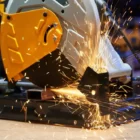The use of cutting fluid in the metal processing industry enables higher cutting speed, higher feed rate, deeper cutting, longer tool life, smoother surface, greater dimensional accuracy and less power usage.
Function of Cutting Fluid in Metal Processing
Almost all of the energy spent during machining turns into heat. Heat is generated during the deformation of the metal to form burrs and as a result of the friction of burrs sliding along the cutting tool. The primary function of cutting fluids is to cool the tool, workpiece and the resulting burrs; to reduce friction at contact points and to prevent and reduce adhesion at the edges that cause burr accumulation on the cutting inserts. Cutting fluids also help prevent rust and corrosion and remove burrs.
What are the Usage Areas of Cutting Fluid?
Cutting fluid has two uses. The first is cooling and the second is lubrication.
Cooling:
The heat generated during metal cutting needs to be removed. The resulting burrs help transfer this heat away from both the cutting tool and the workpiece. The liquid, which acts as a cooling device, removes heat from the burrs and the workpiece. In order to be effective at this point, the liquid must be able to transfer heat very quickly. The coolant absorbs the heat and allows it to travel away.
Lubrication:
Approximately two-thirds of the heat generated in a metal cutting process comes from the atoms in the workpiece resisting being cut. The remaining one-third of the heat comes from the friction created by the burrs on the cutting tool surface. A cutting fluid with good lubricating quality can reduce the friction of burrs sliding on the tool surface. Thanks to lubrication, the cutting angle changes, thus reducing the cutting path and producing a finer burr. Good lubrication also means less molecular distortion, resulting in less internal friction and less heat generation.
Use of Cutting Fluid in Drilling Press
During drilling, coolant should be directed to where the tool contacts the workpiece. The liquid must overflow so that as much liquid as possible reaches the cutting edge. The operator must withdraw the drilling tool from time to time to remove the resulting burrs. The most efficient method is to use tools with integrated oil holes. These tools have a mechanism that feeds the coolant through the tool and directly to the cutting edges, allowing the chips to exit the hole.
Use of Cutting Fluid in Milling Operations
Milling is the process of removing chips by advancing a cutting tool that rotates around its own axis through the workpiece. As much as possible, two nozzles (heads for spraying liquid) should be used in milling operations. One nozzle should be in front of the cutter and the other should be in the back. These two nozzles provide cooling of both the cutting tool and the workpiece; At the same time, the resulting sawdust is also washed.
Use of Cutting Fluid in Turning Operations
Turning is the name given to the machining process with a cutting tool moving linearly on a metal workpiece rotating around its own axis. In the turning process, coolant should be provided to the area where the chip is produced. For turning and leveling operations, the spray nozzle must feed coolant directly onto the cutting tool. For heavy cuts, it is recommended to use two nozzles, one above the tool and the other below.
Use of Cutting Fluid in Grinding Operations
Grinding is the process of removing chips with abrasive tools called emery stones of certain shapes. A lot of heat is generated during this process, so it is necessary to use coolant. The “flood coolant” system should be used when grinding. Spraying should be done from two nozzles whenever possible and the nozzles should be kept close to the workpiece. The entire grinding surface must be covered with liquid.
werte As Cutting Technologies, we aim for the best in every cut. We strive to make everyone perfect with our excellent products and great after-sales support.





